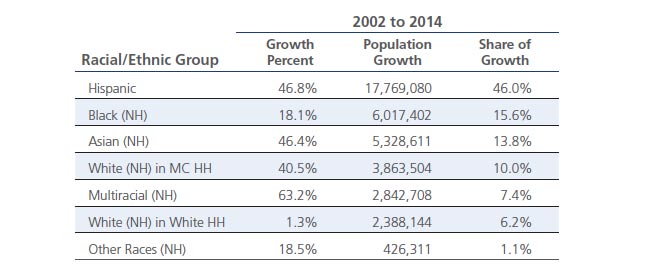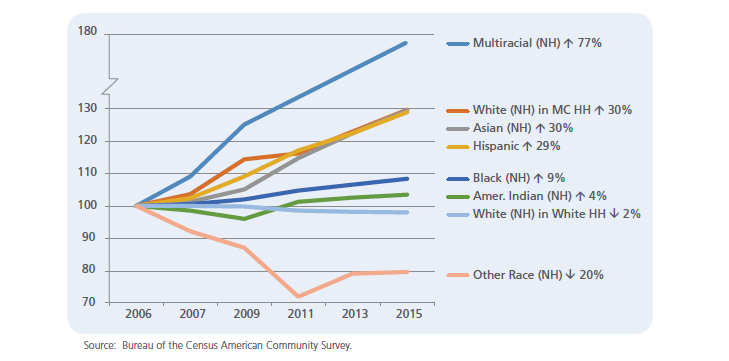The Demographic Imperative
Among the key drivers of American growth and vitality are the demographic and cultural components inherent in the country's diversity. EthniFacts has undertaken an in-depth examination of how the cultural makeup of the U.S. is rapidly evolving and creating new and unprecedented definitions for how Americans identify themselves and their heritage. The results of this examination are presented in a series of Topical Insights; this one documents the recent evolution of race and ethnic self-classifications as reported to and documented in the Bureau of the Census American Community Survey since 2002.
The dramatic shift in how Americans see themselves is shown in the two charts for 2002 and 2014. In 2002, there were just under 281 million persons in the U.S. and almost two-thirds (64.8% or 182 million) were White Non-Hispanics (NH) residing in White-only households. In 2014, there are now over 319 million Americans and White NH in White-only households are now 57.7% of the country's population.

A striking view of the patterns of growth and contribution to population growth is shown in the table.

An additional and more striking view of population trends is shown below. In this line graph of population change trends for the decade from 2006 to 2015, we have set the base population at 100 for each group as of 2006. This base year is appropriate because the American Community Survey data became more stable for year-to-year comparisons at that time. For 2013 to 2015, EthniFacts has projected annual estimates using the trends from actual ACS data through 2012 (last year with released ACS data) and factors relating to migration and internal growth rates.

As shown, the largest percent growth is in the multiracial group expected to expand by nearly 77% over the 10 years. Following are the three biggest population growth engines of America – Hispanics, Asians, and Whites living in households that are multicultural (non-Whites and/or Hispanics in them). These three groups show growth of nearly 30% over the ten years. Black or African Americans are expected to grow by almost 9% in the decade ending in 2015 while American Indians will grow by almost 4%. In contrast, the White NH population living in White-only households is actually declining in the period from 2006 to 2015
Population growth is needed to meet future demand for talent and for workers to replace retirees that will continue to be drawn primarily from the shrinking White-alone population. The strength of United States population characteristics, compared to all developed countries and many developing ones, is growth and the ability to maintain a healthy age distribution and to sustain cultural diversity (topics covered in forthcoming Insights).
The ethnic diversity of White Americans is much greater than is usually observed and is covered in Insight02. The evolution and diversity of Hispanics is the topic of Insight03. Additional Insights on Black Americans, Asian Americans, and the multiracial population will be posted soon.
CLICK HERE TO GO BACK
